
Siphons, Towers, & Strings of Beads
A tower naming convention
In this essay, several different orbital towers are described. There are probably many more species of tower. And this creates a naming problem. How is it best to name these different kinds of towers?
In the approach suggested here, instead of towers being named Tom, Dick, and Harry and the like, they are named using acronyms which conform with a loose set of rules. The original 1997 orbital siphon was also called a Free Launch Escape Rigid Tower, or FLERT, and the naming convention follows from this. As most of them are Radial Towers, a radial tower becomes an RT. When they raise a train of vehicles to escape from the tower, they are Escape Radial Towers, or ERTs. If they are orbiting radial towers, like Pearson's tower, they are ORTs. All the towers discussed here are also equatorial towers (although non-equatorial towers may be possible). The chosen acronym ought to incorporate enough letters to adequately describe them. It should also preferably be pronouncable as a word. And these words should preferrably not be existing words (like INERT or SORT).
ORT: Orbital Radial Tower
In 1975, Jerome Pearson published a paper titled The Orbital Tower: a spacecraft launcher using the Earth's rotational energy. The top of this radial tower had a radius of 150,328 km, or a height above the Earth's surface of 143,950 km, and was located at the equator of the Earth. The tower was in tension along its entir length, with a tension maximum at synchronous orbit radius of 42166 km.
Such an orbital radial tower can be represented, in principle, as a string of beads, hovering just above the surface of the Earth, and in geostationary orbit.
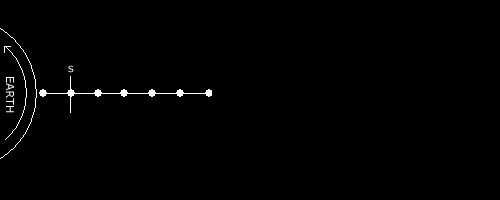
Pearson imagined that spacecraft could ascend and descend this tower. Spacecraft released from the top would have a velocity of 10.93 km/s, sufficient to reach Saturn.
In a range of towers ranging in height from 0 km to 400,000 km, Pearson's orbital tower might be regarded as the one single tower that remains in geostationary orbit. Any tower lower than Pearson's tower tends to fall towards the Earth. And any tower below 36000 km would also tend to buckle under compression. Equally, any tower higher than Pearson's tower will tend to rise away from the Earth.
THEORT: Tethered High Equatorial Orbital Radial Tower
Such high radial towers must be tied to the surface of the Earth if they are to be prevented from floating off into space. The ties at the base would therefore be in tension. And the higher the tower, the higher the tension. Whereas conventional buildings are in compression along their height, and act to compress the Earth, high radial towers that are in tension along their entire length would tend to uproot themselves from the Earth, and would need very unusual foundations - possibly 'roots' extending deep into the Earth - to prevent this outcome.
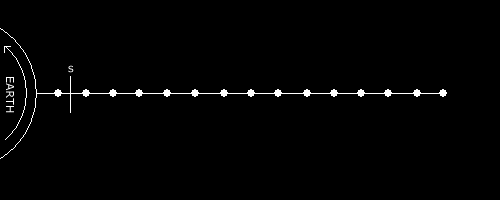
There is no particularly obvious use for such high immobile radial towers (HIRT). They would offer increasing spacecraft release velocities at their tops. And if released, the potential energy stored in them would allow them to lift some amount of mass some distance above the surface of the Earth. They might be used as heavy lifting towers, which might be used to lift and transport large masses in equatorial regions
TECTERT: Tethered Equatorial Cantilever Truss Escape Radial Tower
Yet another kind of equatorial tower is an Escape Radial Tower - or siphon -, in which a continuous train of vehicles rises radially to escape at the top of the tower. This rising train exerts coriolis forces which need to be counteracted to maintain angular velocity and radial tension.
One way of countering coriolis forces is with a static truss, along which the rising train of vehicles rises, much like a railway train on a track.
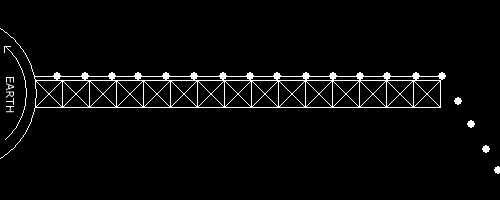
This kind of escape tower has two components. The first component is a passive cantilever truss which has the necessary strength to resist coriolis forces. The second component is a train of vehicles which rises up the cantilever truss.
The truss might be regarded as being made up of two THEORTs braced together.
TELTERT: Tethered Equatorial Lateral Thruster Escape Radial Tower
A variant Escape Radial Tower actively counters coriolis forces with lateral thrusters mounted on the rising vehicle train.
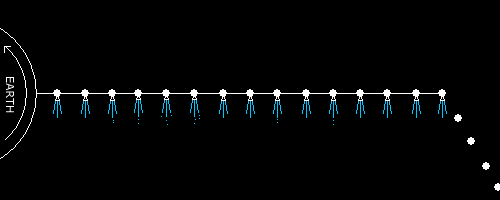
The principle advantage of this approach would be to be remove any need to build a cantilever truss prior to raising a train of vehicles.
However, enough propellant would have to be added to each payload to power its thruster for the entire duration of the ascent.
TELTBIERT: Tethered Equatorial Lateral Thruster BInary Escape Radial Tower
One possible solution to the problem of providing fuel for these thrusters might be to construct a fast fuel train rising inside (or beside) the main payload train. If the payload train rose at 1 km/s, the smaller fuel train might rise at 10 km/s, refuelling payload thrusters as it climbed, and ideally not releasing any fuel from the top of the tower.

The advantage of this approach would be that thrusters would have relatively small fuel stores, which would be topped up periodically from the fuel train. The disadvantage is that the fast fuel train would increase coriolis forces, and the required thruster counterforce. Also, as the fuel train dropped off packets of fuel, it would no longer have an even distribution of mass along its length, but would tend to be light at the top, heavy at the bottom - which might disable it from rising.
The fuel would have to be stored in containers (with 8 containers of oxygen for every one container of hydrogen, in the case of a Hydrazine binary fuel). But if the fuel must come in tanks of some sort, then a variant scheme would be for the fuel train to become a thruster train, with fuelled-up thrusters replacing spent thrusters. And since the thrust required is constant, thrusters might use solid fuels which burned at a constant rate.
And if the fuel train is replaced with a thruster train, another possibility might be to mount the thrusters laterally in the train, and have the train rise along the trailing western side of the payload train, and progressively fire up the thrusters as they rose up the payload train.
TRECTERT: Tethered Rising Equatorial Cantilever Truss Escape Radial Tower
Another possible variant Escape Radial Tower would consist of a train of vehicles with in-built lateral strength - in effect a rising cantilever truss.
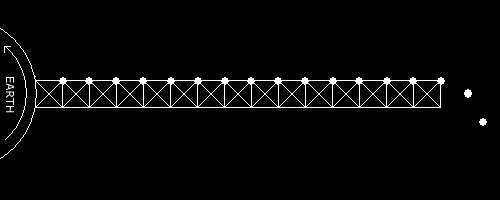
In this version, the truss is discarded at release, leaving only the payloads. Another variant might release whole sections of the truss.
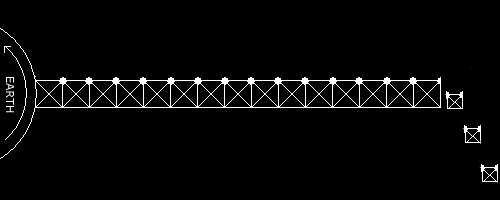
Once released, these sections would tend to contract as stretched ties return to their unstretched length.
Note: none of these animations have been drawn to scale.
